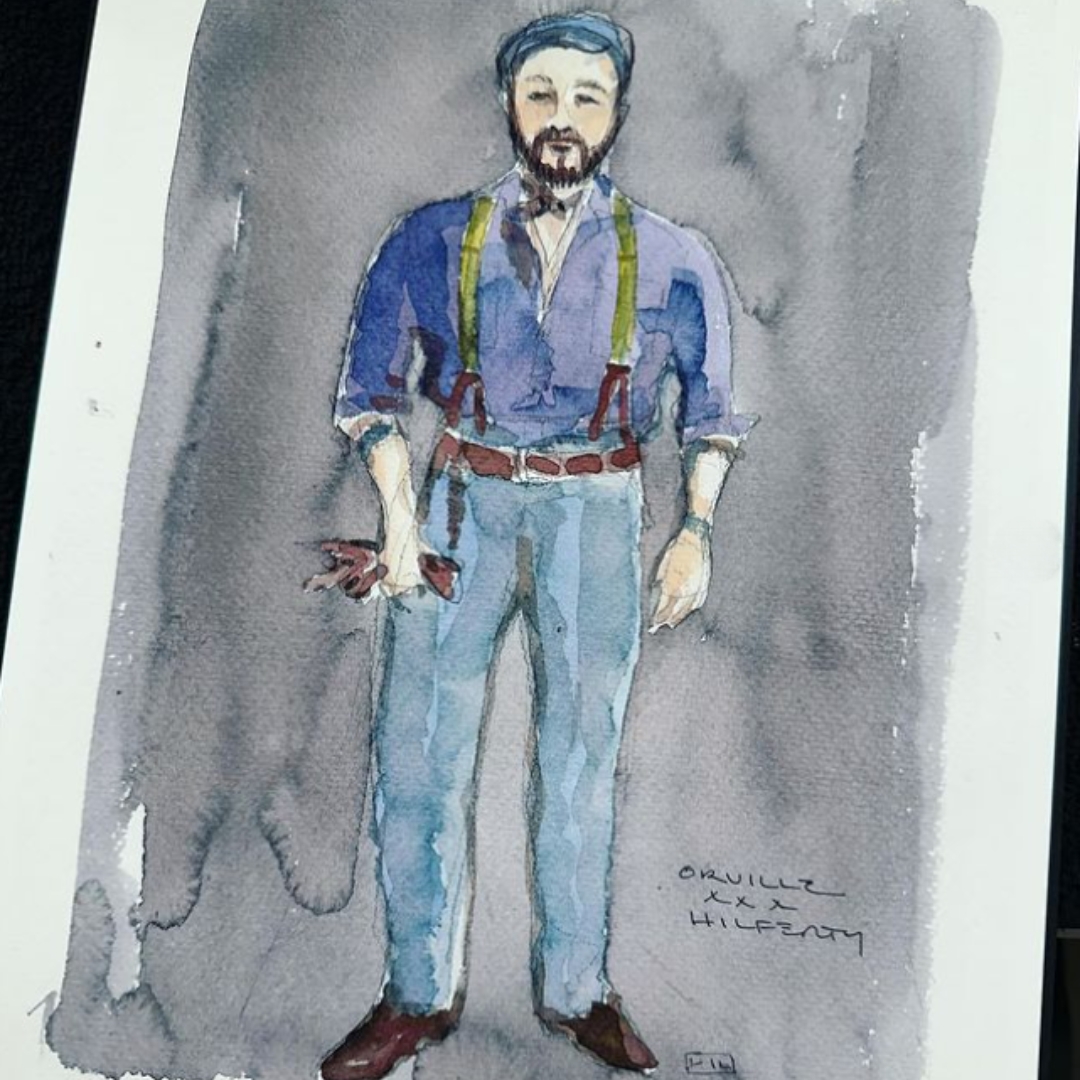
“A costume is a story that you wear.”
— Joseph Salasovich, Arena Stage’s Costume Director

Costumes are a form of visual storytelling. They can tell us who a character is—their lifestyle, their traits, their history, and their hopes. Costumes can also help show what has happened to a character. When creating the costumes for Swept Away, Arena Stage’s Costume Director Joseph Salasovich noted how the designs reflected the “message of the play—the sea has its own rules.”
Knowing how the sea impacts the lives and clothing of the characters led the Swept Away costume designers to make certain choices. For example, some sailors on the ship are experienced, so their costumes are more worn and have repairs that are done perfectly because sailors were expert stitchers. The characters Little Brother and Big Brother, however, came from a farm and are new to the sea, so this had to be reflected in their costumes.
For this Arena Stage production, the costume team both used original pieces from the world premiere production at Berkeley Repertory Theatre in 2022 as well as created some new pieces for the cast. The costumes were designed by Susan Hilferty.
SUSAN HILFERTY

Susan Hilferty is a visionary costume and set designer renowned for her transformative work in theater, opera, and film—she has designed sets and costumes for over 400 productions across the globe. Her many Broadway designs include Parade (2023 Revival), Wicked, Hands on a Hardbody, Spring Awakening, and Into the Woods (2002 Revival).
Her designs are known for their meticulous attention to detail, innovative use of materials, and a profound understanding of storytelling through attire. Hilferty’s portfolio boasts collaborations with esteemed institutions worldwide, earning her numerous accolades, including a Tony Award for Best Costume Design (for Wicked). Her passion for merging artistry and narrative has established her as a trailblazer in the world of costume design.

I don’t think the public realizes the detail and the specific storytelling Susan Hilferty puts into each costume. Some things are specific to me and my culture. Most of these details will go over people’s heads, and that’s fine. It’s just another layer to discover when coming back to see our show. I loved our talks about family and sharing my knowledge of Filipinos in America founding the fishing village of Saint Malo in Louisiana in the 1700s. How a Filipino could actually be on a whaling vessel in 1880. How because of this small gesture, we are finally acknowledging a whole culture that existed in America since the beginning of colonized America that has never been included in American stories before.
I am in awe of Susan and forever grateful for the collaboration.
AGING AND DISTRESSING COSTUMES
Careful research is critical to a costume telling its story. The designer and costume team researched the play’s time period and the lives of sailors and applied this research to their work. To make clothes look like they had spent months or even years at sea required a process of aging and distressing.

Deborah Nash, the craftsperson in Arena’s costume shop, helped achieve this effect. “Lots of watercolor, textile paint, and water goes into changing the color and appearance of costumes for Swept Away,” Deborah said. “Paint is used to add the effect of saltwater on costumes for sailors working closer to the edge of the boat. For costumes worn post-shipwreck, sandpaper is used to distress the edges of the clothes.
DUPLICATING WITH DYE
Actors frequently have morning and evening shows which require the same costume. Because there isn’t always enough time for the wardrobe team to wash and iron the same shirt, duplicates are made. These allow actors to have a fresh costume without having to worry about sweat from the last performance. Duplicate costumes are also needed for understudies. Deborah’s challenge was to create a duplicate shirt based on one worn in the Berkeley Rep production.
Because the fabric for the original shirt couldn’t be found, Deborah started with brand new shirts that had a similar color, texture, and design. She then “stripped” them of their color and used Rit (a brand of household dye) to overdye and create the desired color of the new shirts.

Stripping is the process of removing dye from fabric using products such as soda ash to lighten and fade its appearance. Watch more about that process here. Deborah keeps a binder of tester fabric to help identify how different dye colors affect different fabrics, like wool vs. cotton or silk vs. nylon. Because these shirts were cotton, she had to try different color combinations or “recipes” to reach the desired effect. Deborah used a vat made specifically for dying clothes. To track her progress, she used a fabric swatch from the original shirt to compare the color accuracy of the new shirt duplicates. When a shirt didn’t match the original color, she would try a different dye recipe. This process of nonstop changes is what builds the final look for costumes.
SWEPT AWAY
The costumes for Swept Away are as detailed and layered as its characters. Hilferty’s original designs were maintained and expanded by Arena Stage’s costume shop to create the final look. Much like the whalers in the 18th-19th centuries, the work of the costume crew uplifts the value of hard work to produce an excellent result.
If you haven’t seen Swept Away yet, you now have through January 14 to see these costumes in action. Buy tickets now!
Stark Sands, John Gallagher, Jr., Wayne Duvall, and Adrian Blake Enscoe in Arena Stage’s East Coast premiere of Swept Away. Photos by Julieta Cervantes.
Micaela Diamond and Ben Platt in Parade. Photo credit: ©2022, Joan Marcus.
Tovah Feldshuh and Jared Grimes in Funny Girl. Photo by Matthew Murphy.
Roundabout Theatre Company’s Assassins (l-r) Alexander Gemignani, Becky Ann Baker, Jeffrey Kuhn, Michael Cerveris, Neil Patrick Harris, Mario Cantone, Mary Catherine Garrison, Denis O’Hare, James Barbour. Photo credit: ©2004, Joan Marcus.
Fabric Dye images from Scienceclubatoms and molly jane nicholas




